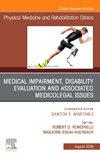Optimizing Musculoskeletal Management Following Spinal Cord Injury
IF 2
4区 医学
Q3 REHABILITATION
Physical Medicine and Rehabilitation Clinics of North America
Pub Date : 2024-10-28
DOI:10.1016/j.pmr.2024.07.003
引用次数: 0
优化脊髓损伤后的肌肉骨骼管理:实践管理的最佳做法。
50%-81%的脊髓损伤患者会出现肌肉骨骼疼痛。疼痛会产生严重的限制性影响。疼痛会导致行动不便、耐力下降、社会参与度降低和抑郁。此外,许多脊髓损伤(SCI)患者依靠上半身进行日常生活活动(ADLs),这可能导致他们在剧烈疼痛时独立性下降。与脊髓损伤相关的肌肉骨骼损伤包括肌肉质量和骨密度下降、痉挛、挛缩以及肌肉、肌腱和关节的过度使用损伤。这些问题会导致脊髓损伤患者疼痛和发病。然而,目前还缺乏对 SCI 患者罹患这些疾病风险的研究。本文旨在调查和概述 SCI 后常见的 MSK 病症。SCI 患者经常会出现的其他肌肉骨骼损伤包括但不限于肌肉萎缩、骨质疏松症、骨折、痉挛、异位骨化、肌腱病和单神经病变。
本文章由计算机程序翻译,如有差异,请以英文原文为准。
求助全文
约1分钟内获得全文
求助全文
来源期刊

Physical Medicine and Rehabilitation Clinics of North America
REHABILITATION-
CiteScore
3.30
自引率
0.00%
发文量
82
审稿时长
6-12 weeks
期刊介绍:
Physical Medicine and Rehabilitation Clinics updates you on the latest trends in patient management, keeps you up to date on the newest advances, and provides a sound basis for choosing treatment options. Each issue focuses on a single topic in physical and rehabilitation medicine and is presented under the direction of an experienced editor. Topics include brain injury rehabilitation, electrodiagnosis, geriatric rehabilitation, musculoskeletal medicine, neuromuscular medicine, pain management, spine medicine, sports medicine/ortho rehabilitation, and stroke/neurologic rehabilitation.
Physical Medicine and Rehabilitation Clinics publishes four times per year, in February, May, August, and November.
 求助内容:
求助内容: 应助结果提醒方式:
应助结果提醒方式:


